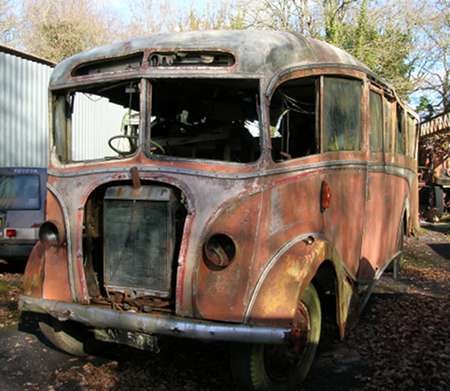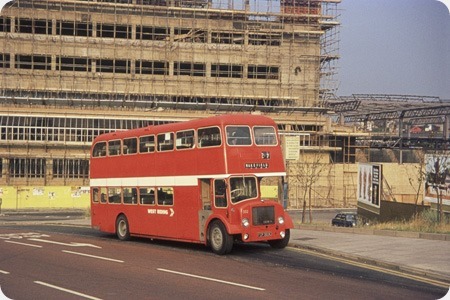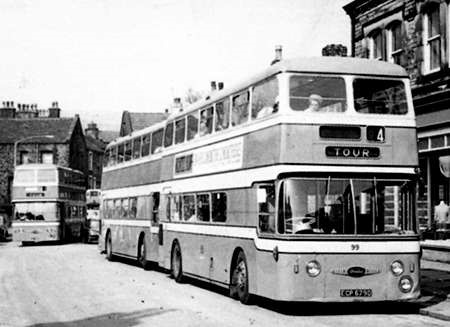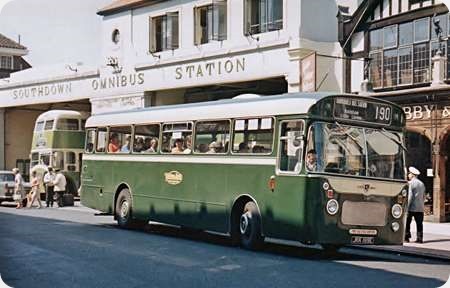Karefree Travel – Austin CXB – NPF 140
Karefree Travel
1948
Austin CXB
Mann Egerton C31F
There appears to be some confusion about the exact model definition of the immediate post war Austin passenger model range. The Austin “near clone” of the Bedford O haulage vehicle was the K type, and the equivalent passenger model (and OB lookalike) was the CX. Some sources suggest that the bonneted model was simply classified CX, and this became the CXB in forward control form. Others state that the bonneted type was the CXB and the forward control version the CXD. When a Perkins P6 diesel option was offered from around 1950 the type became CXD Series II, which appeared in 1956 in Series III form, essentially for export, with the BMC 5.1 litre diesel. However, pictures of the bonneted model and the forward control version are both frequently described it being the CXB, so what is the true position? The Commercial Motor for 1st October 1948 states that the first forward control CXB example which appeared at the Commercial Motor Show in that year was converted from normal control by the Norwich based coach builder and Austin dealer Mann Egerton. A picture of this exhibit may be found here carrying the fictitious registration number M(ann) E(gerton) 1949:-
www.stilltimecollection.co.uk/ I remain sceptical that the 1948 forward control conversion was entirely carried out by Mann Egerton as production examples from Austin began appearing shortly after the Earls Court Show, though it may well be that the Norwich based coach builder put pressure on, and collaborated with, Austin in bringing the model to the market. The standard coach bodywork by Mann Egerton for the forward control CXB was given the name “Norfolk” and was distinguished by its curiously sculpted front end to which the standard Austin radiator grille (an upsized version of the shape employed on the cars) was rather incongruously attached. The result certainly lacked the businesslike appearance of the Bedford SB that appeared in 1950. Somewhere around 1953 the Norfolk body became rather more stylish, but the Austin coach was then in its twilight days on the home market, though exports continued into the 1960s. The 1947 bonneted Austin CX series originally had a 67 bhp 3½ litre petrol engine, but from 1948 this was upgraded with a 68 bhp 4 litre unit. The gearbox was a four speed synchromesh, which compared favourably with the crash box of the Bedford OB, but, unlike the Austin, the Bedford had servo assisted brakes and remained the more popular type by far.
NPF 140 shown above was photographed in the large Croydon council estate of New Addington in 1960, and bore the trading name Karefree Travel about whom I know nothing. The livery bears a close resemblance to the 1948 Show exhibit – could it be the same vehicle, I wonder?
It can also be seen in this 1950 shot taken in Parliament Square.
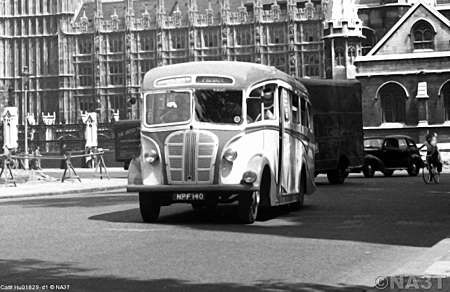
Copyright NA3T Arthur Hustwitt (Memorial)Collection)
Some interesting comments concerning the relative merits of the Bedford OB and the Austin CX range may be found here (scroll halfway down):-
www.martynlnutland.com/
Photograph and Copy contributed by Roger Cox
19/07/17 – 11:07
In John Carman’s excellent book, AUSTIN K SERIES BUSES & COACHES, the following information is shown.
NPF 140, FC31F, K4/CXB, Mann Egerton, 139990, 9/49. L.G Lambird (Carshalton & Wallington Coaches) Wallington Surrey
John Rentell
20/07/17 – 07:20
John Carman’s book has an appendix of all the known Austin K series (including the 3 way van based K8) It also explains in detail the different designations.
Well worth £12 including p&p direct from John at Mont du Herissaon Grande Maison Road St Sampson Guernsey GY2 4JH
John Wakefield
21/07/17 – 07:07
Amazing that a postwar 31-seat coach should have no servo braking. As with the Bedford OB, the appearance of this Austin coach suffers from the narrowness of the front track, which shows up to particular disadvantage in the lower photograph, but even with a full-width front axle the top-heavy, ungainly body design would still spoil the whole effect. Why were just-postwar builders and their customers not content with simple, unpretentious, straight-waisted bodywork that sat easily on the chassis instead of appearing to crush it? The CXB chassis deserved better! Thanks too, Roger, for the fascinating link.
Ian Thompson
29/07/17 – 07:10
I have one of the forward control model of these and I see that, whilst the log book doesn’t specify the chassis type, the chassis number itself is prefixed CXB. Don’t know if that helps.
Peter Cook
30/07/17 – 06:44
That’s useful, Peter. Could we see a photo and some history of your rare vehicle and how you came to acquire it?
Chris Hebbron
01/08/17 – 07:25
Chris. I regret to say that my knowledge of the history of the vehicle is limited. The reg. no. is MAF 544 so presumably it came from a Cornish operator. Chassis is CXB139946. As much as I know of the histroy is that it was acquired by Colin Shears at some stage and subsequently sold to someone who I think came from Plymouth. After it had spent a number of years outside, the would be preservationist decided that it was too far gone and returned it to Colin. I then acquired it from Colin. The bodywork was beyond salvation and went to Barnsley packed inside a Leyland National. I did keep some of the more iconic panels in case anyone wanted them. The chassis is being renovated.
Peter Cook
02/08/17 – 07:00
Peter; check out //www.sct61.org.uk/zzmaf544
John Lomas
02/08/17 – 07:02
Thx, Peter, for taking the trouble to post the photo and what history you’re aware of.It’s always sad to see old vehicles reach this stage, but doubly so when they are rare to start with. Saving the chassis is, nevertheless, a fruitful enterprise. Good luck with that.
Chris Hebbron

